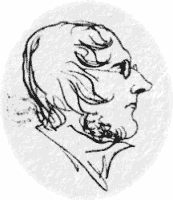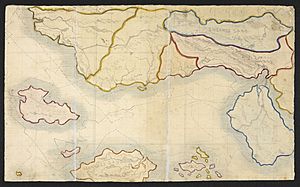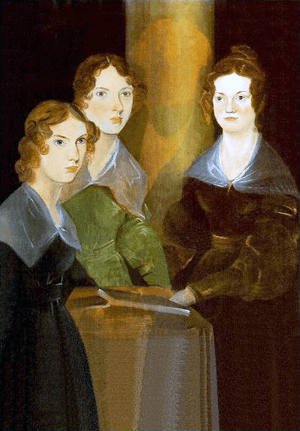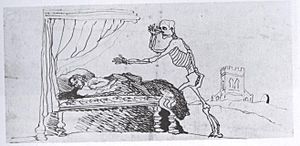Branwell Brontë facts for kids
Quick facts for kids
Branwell Brontë
|
|
|---|---|

Branwell Brontë, self-portrait, 1840
|
|
| Born |
Patrick Branwell Brontë
26 June 1817 Thornton, West Riding of Yorkshire, England
|
| Died | 24 September 1848 (aged 31) Haworth, West Riding of Yorkshire, England
|
| Occupation | Painter |
| Parent(s) | Patrick Brontë Maria Branwell |
| Relatives | Brontë family |
Patrick Branwell Brontë (born June 26, 1817 – died September 24, 1848) was an English painter and writer. He was the only son in the famous Brontë family. His sisters were the well-known writers Charlotte, Emily, and Anne. Branwell was taught at home by his father. He was praised for his poems and his translations of old classic texts. He tried different jobs, often earning money by painting people's pictures. Branwell Brontë died when he was 31 years old.
Contents
Early Life and Education
Branwell Brontë was the fourth of six children. He was the only son of Patrick Brontë and Maria Branwell Brontë. He was born in Thornton, near Bradford, England. His family moved to Haworth in 1821 when his father became a church leader there.
Unlike his sisters, Branwell was educated at home by his father. His father taught him many subjects, including classic languages like Latin and Greek. Elizabeth Gaskell, who wrote a book about his sister Charlotte, said that his father believed Branwell would learn best at home. Sadly, his two oldest sisters died in 1825, just before his eighth birthday. This loss affected him greatly.
Even as a young boy, Branwell loved to read. He especially enjoyed "Noctes Ambrosianae", which were literary discussions in Blackwood's Magazine.
Imaginary Worlds and Stories
Branwell and his sister Charlotte led a series of fantasy role-playing games. They wrote and acted out stories about "Young Men" characters. These characters were based on a set of wooden soldiers. Their plays grew into a complex saga set in West Africa. This saga was about a made-up place called the Glass Town confederacy.
From 1834, Branwell worked with Charlotte to describe another imaginary world called Angria. Branwell was very interested in the politics and wars of these imaginary places. He wrote about the rivalry between Charlotte's hero, Arthur Wellesley, and his own character, Alexander Percy. These writings show how talented and imaginative he was.
A historian named Christine Alexander studied the Brontë children's early writings. She noted that Branwell and Charlotte made sure their imaginary world stayed consistent. If Branwell made big changes, Charlotte would often help fix them in the next stories. Branwell was proud of organizing their private world. He kept detailed lists, notes, sketches, and maps. These showed the geography, history, and government of the Glass Town Federation and later Angria. He often used different pen names, like Captain John Bud or Chief Genius Bany. These were also characters in their stories.
In January 1829, when he was 11, Branwell started his own magazine. It was later called Branwell's Blackwood's Magazine. It included his poems, plays, and stories.
Early Career Attempts
Branwell did not prepare for a specific career like his sisters did. He tried to find work by writing to Blackwood's Magazine several times. He sent poems and offered his services, but his letters were never answered.
In 1829–30, his father hired John Bradley, a local artist, to teach the children drawing. Bradley likely encouraged Branwell's love for art. After Bradley moved away, Branwell continued his studies with another portrait painter, William Robinson. In 1834, Branwell painted a famous picture of his three sisters. He originally included himself in the painting but later painted himself out. This portrait is now one of the best-known images of the Brontë sisters. It is displayed in the National Portrait Gallery.
In 1835, Branwell wrote a letter to the Royal Academy of Arts. He wanted to be accepted there to study painting. Some people thought he went to London but spent all his money. Others believed he was too scared to go. Newer research suggests he might not have even sent the letter or traveled to London.
Branwell worked as a portrait painter in Bradford in 1838 and 1839. Some of his paintings, like those of Mrs. Kirby and Emily, show his talent. However, other portraits were not as lively. He returned to Haworth in 1839 with debts.
Adult Life and Work
Branwell studied classic texts with his father. He hoped to become a tutor. In January 1840, he started working for the Postlethwaite family in Broughton-in-Furness. During this time, he wrote letters to his friends in Haworth. These letters show his humor and his desire to be accepted by other men.
While working, he continued his writing. He sent poems and translations to writers Thomas De Quincey and Hartley Coleridge. Coleridge invited him to his home and encouraged him to continue translating Horace's Odes. Branwell sent his translations to Coleridge in June 1840.
In October 1840, Branwell moved near Halifax. He had many friends there, including sculptor Joseph Bentley Leyland. He got a job with the Manchester and Leeds Railway. He started as an assistant clerk at Sowerby Bridge railway station. Later, in April 1841, he was promoted to clerk at Luddendenfoot railway station. In 1842, he was dismissed from this job due to a small amount of missing money. This was likely due to his inattention rather than theft.
Francis Leyland, a friend, described Branwell at this time. He said Branwell was "rather below middle height" but looked refined and gentleman-like. He had a fair complexion and handsome features. His eyes sparkled, and his forehead gave his face an oval shape. Another person described him as "almost insignificantly small" with "a mass of red hair" and "small ferrety eyes."
In January 1843, Branwell took another tutoring job in Thorp Green. He taught the young son of Reverend Edmund Robinson. His sister Anne had been the governess there since May 1840. At first, things went well. Charlotte wrote that her siblings were "both wonderously valued in their situations."
In July 1845, Branwell was dismissed from his position. He returned home to the Haworth parsonage. He looked for another job and wrote poetry. He also tried to turn his Angrian stories into a book called And the Weary are at Rest. In the 1840s, some of his poems were published in local newspapers. He used the name Northangerland. This made him the first of the Brontës to have his poetry published.
Later, Branwell's behavior became more difficult for his family. Charlotte's letters show she was upset by his actions. In January 1847, he wrote to his friend Leyland about wanting an easy life. He hoped "to try and make myself a name in the world of posterity, without being pestered by the small but countless botherments." His father had to sleep with him at times to keep the family safe. Charlotte Brontë wrote that Branwell died without knowing his sisters had published their own works. However, some believe he might have known about their poetry book.
Death
Branwell Brontë died on September 24, 1848, at Haworth parsonage. He most likely died from tuberculosis. Elizabeth Gaskell's book about Charlotte says that Branwell wanted to show the power of human will. He insisted on standing up when he died. On September 28, 1848, he was buried in the family tomb.
His sister Emily Brontë also died from tuberculosis later that year, on December 19. Anne Brontë died on May 29, 1849. Charlotte, the last living sister, married in 1854 and died in March 1855.
Works
Poems
- "Lines Spoken by a Lawyer on the Occasion of the Transfer of This Magazine"
- "On Caroline"
- "Thorp Green"
- "Remember Me"
- "Sir Henry Tunstall"
- "Penmaenmawr"
- "Real Rest"
- "Letter from a Father on Earth to His Child in Her Grave"
- "The End of All"
Juvenilia
(written with his sisters)
- Battell Book
- The Glass Town
- The Young Men's Magazine, Number 1 – 3 (August 1830)
- The Revenge A Tradgedy
- The History of the Young Men from Their First Settlement to the Present Time (1829–1831)
- The Fate of Regina
- The Liar Detected
- Ode on the Celebration of the Great African Games
- The Pirate A Tale
- Real Life in Verdopolis, volume 1–2
- The Politics of Verdopolis
- An Angrain Battle Song
- Percy's Musings upon the Battle of Edwardston
- Mary's Prayer
- An Historical Narrative of the War of Encroachment
- An Historical Narrative of the War of Agression
- Angria and the Angrians
- Letters from an Englishman (1830–1832)
- Life of Warner Howard Warner
- Tales of Angria (written 1838–1839 – a collection of childhood and young adult writings including five short novels)
See also
 In Spanish: Branwell Brontë para niños
In Spanish: Branwell Brontë para niños




